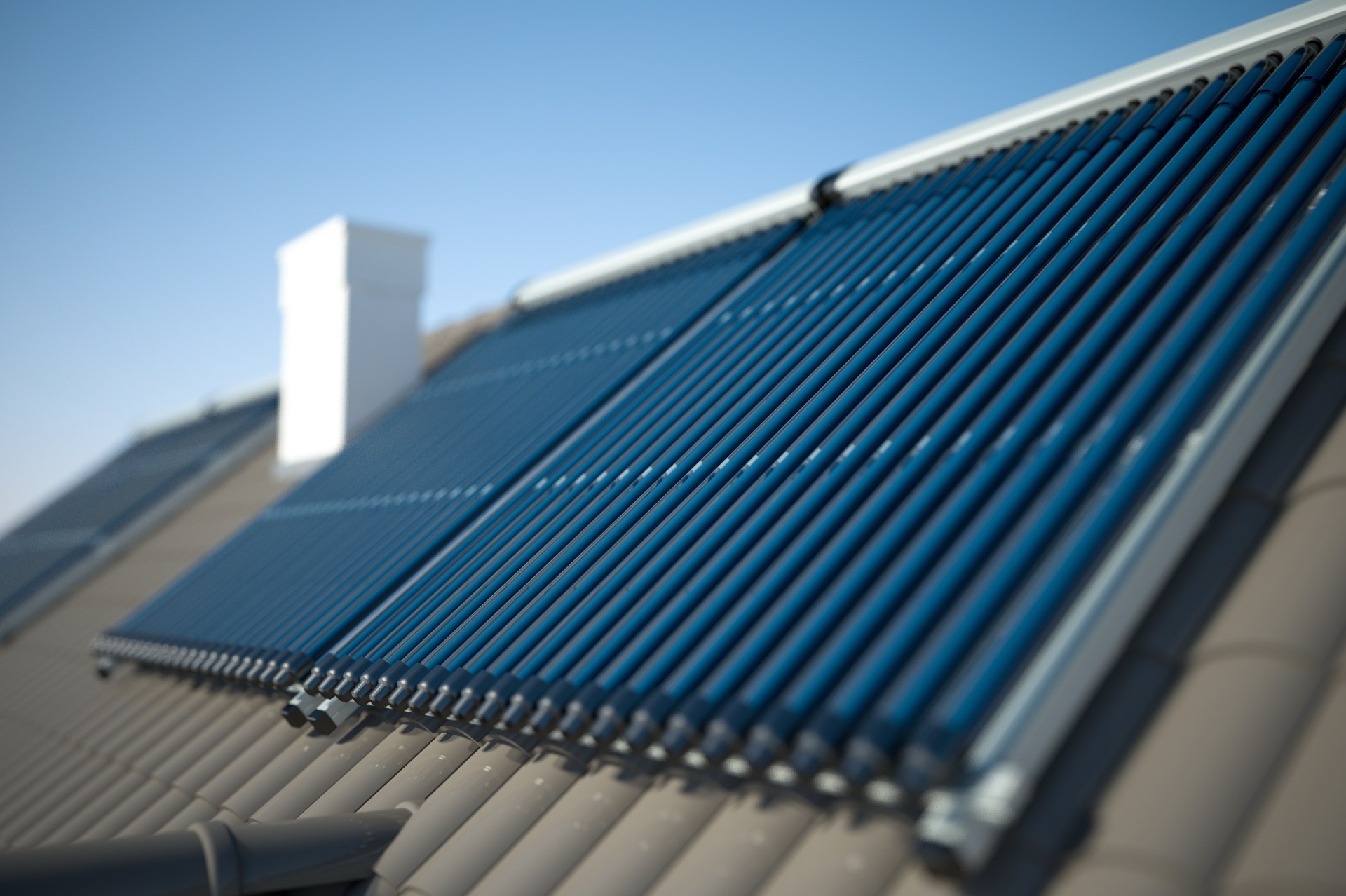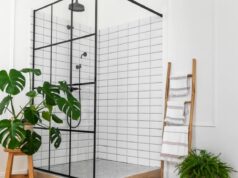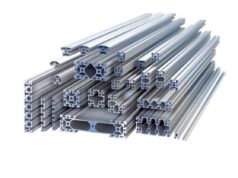There are two main ways to utilize a solar water heater. Firstly, you have a system that uses antifreeze solution which circulates through pipes in a large, flat, enclosed box known as a flat plate collector. Secondly, you have various vacuum tubes that are in an arrangement for what is called an evacuated tube collector.
A solar water heater works as solar heat transfers to the liquid during water movement through the system. The first type which uses a flat plate collector is known as a thermosyphon system where water moves into a storage tank and is used directly. In an evacuated tube collector or drain-back system, solar heated liquid which can be water but most often is antifreeze flows into a heat exchanger inside a water storage tank where it heats potable water, and as a result, the liquid is not used directly. Potable water means water that is safe for drinking or consumption purposes. In this article explore the various types and help you select the best solar water heater.
Storing hot water in a separate tank is required because it takes longer for water to heat up via solar power, so this ensures that enough supply is available during the night and early morning when consumption levels are high, but there is little sunshine.
Solar heaters are paired with traditional gas or electric water heater which can be either a tank or tankless system that is the point of use so that there is an uninterrupted supply of hot water during cloudy periods. However, in a solar water heater system, conventional methods to heat water are only used when there is not enough sunshine available. Also, the solar water heater works anytime the sun is out, even during the winter.
There are many different hot water collectors available. You can choose to purchase all the components including the collector and tank separately and assemble them yourself, or you can buy through a local distributor which can install the entire system for you. It is possible to save money by assembling and installing the solar water heater yourself, but we don’t recommend it unless you have expertise in this area. You can build your own collector using wood, copper pipe, and polycarbonate glazing if you wish to.
Hot water collectors can serve multiple purposes at once. For example, if you live in a warm climate such as Arizona or California, solar water heaters can account for up to 80% of your heating needs while working in conjunction with a conventional tank/tankless gas or electric heater to provide the remaining 20% of warm water. This results in significant savings off your energy bill. Furthermore, electric tankless systems when paired with solar water heaters can result in even more savings because they are the point of use and have tremendous benefits for the environment. Hot water collectors can be used to heat water for the pool, hot tubs, and heating systems too.
Flat plate collectors and Thermosyphon systems
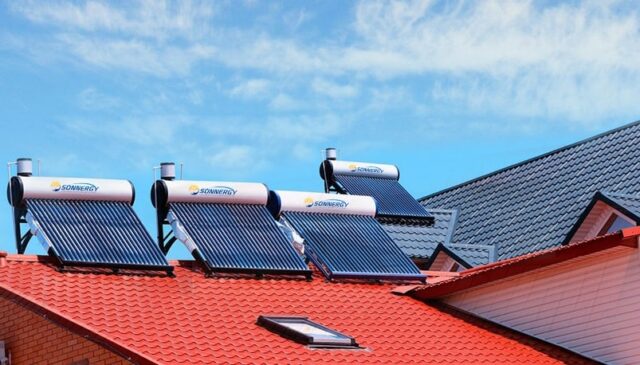
Flat plate collectors are the panels responsible for harnessing the sun’s energy to heat potable water. A copper tubing heater panel if most often the type of material chosen to work with a solar water heating system. In warm climates, a thermosyphon storage tank is ideal while in cooler climates a rooftop or wall collector with a drain-back system works best. You can also use a flat plate collector with a system comprising of antifreeze but will require special plumbing and safety features to avoid polluting the water supply and is best to speak to a professional before installation.
A flat plate collector is built with wood, a layer of insulation to retain heat, and a panel made from polycarbonate. Polycarbonate is a kind of clear acrylic that combats the UV damage that stains and cracks regular acrylic so make sure you understand this difference if you are about to embark on a DIY project. Inside the collector system, heat consolidates and transfers to pipes by thin aluminum panels lining the box and shapes over the copper. Just as the water heats inside the tubes, it flows upwards into the top chamber of the storage tank and switches places with cool water from the bottom of the storage tank. This replacement continues until the water in the storage tank is warmer than the water in the collector at which point the thermosyphon action stops and the thermostatically controlled pump switches off.
Thermosyphon water heaters are very straightforward systems because they don’t need any pumps or control valves to displace the hot water and can be used in a direct manner with no requirement of a heat exchanger. However, they require a storage tank so that they can store the warm water and keep it flowing through the collector. Without the additional storage tank, the water would either flow too quickly or stop and get overly hot.
As water in the copper pipes gradually warms up, the siphoning action begins to circulate the water. As a result, the water rises through the collector and then upwards to the top chamber of the storage tank. The rising water pulls cool water down from the bottom of the storage tank into the collector, and this process keeps repeating until the storage tank water is warmer than that inside the collector. During the night the water in the collector stays cool and heavy, and the system stops. It resumes during the morning when the sun rises, and solar power begins to flow back into the system.
There are some drawbacks if you opt for the simpler setup because unless you are in an area where temperatures rarely fall below freezing, the system needs to be drained and closed off during the winter. The second major pitfall is that you must position the storage tank at least a foot above the level of the collector panel; otherwise, the thermosyphon effect won’t work. That is why you often see the storage tank connected to the collector and positioned outside rather than indoors. Furthermore, because the storage tank rests above the collector, you will need a thermostatically controlled water pump between the two parts so that cold water can flow upwards, and heated water can make it way downhill. Therefore, this simple system works ideally in warm climates because colder climates demand the storage tank be positioned inside the house which can mean higher installation costs.
The thermosyphon collector heaters pressurized water from the home’s water supply, so it is important you select a tank that is both insulated and built to handle pressurized hot water. Storage tanks can be bought from most plumbing supply stores, or you can order online, and they’ll include all the necessary inlets and outlets.
Thermosyphon collector solar water heaters for colder climates are configured in the following way. Firstly, the cold water from the base of the storage tank flows to the solar collector and becomes heated. Next, the heated water flows to the upper part of the storage tank and replaces the cold water, and when these two reach an equilibrium temperature, the process of water flow stops. Whenever the faucet is turned on to a hot water position, the water from the storage tank flows into the cold-water inlet of the heater then to the fixture. After that, cold water from the main supply flows to the storage tank to be heated. In winter the solar collector is drained but continues to work to heat water to room temperature.
Drainback systems
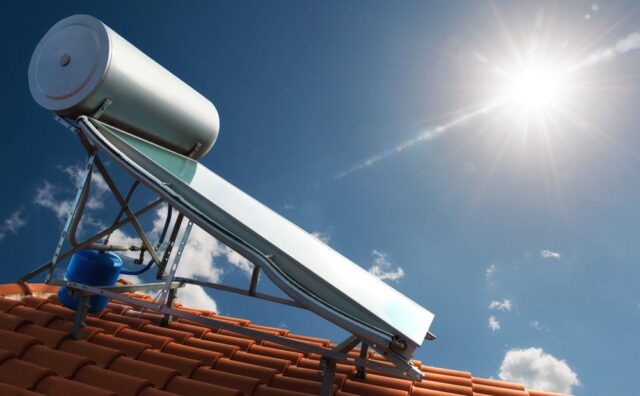
Drainback systems are ideal for cold climates because there is no worry about the water freezing on nights when the temperature is below zero degrees Celsius. In a drain-back system, you can still resort to using a flat plate collector, but the storage tank does not need to be positioned outside the house. A pump controls the water flow and ensures that enough displacement occurs inside the storage tank to provide a consistent supply of hot water. There is no pressurization or connection to a potable water system. Instead, heat passes to the pre-existing pressurized home water system through a heat exchanger such as a coil of PEX tubing.
A temperature sensor works to detect when the collector becomes hotter than the temperature of the water in the storage tank and turns it off if the water is beginning to overheat. When the pump is off, the water drains back into a storage tank side the house. Even though outside power is needed to run a drain-back system, they are more reliable in colder climates and can be used year-round.
Drainback systems don’t require manually draining of the tanks during the winter (if you live in a cold climate) but are automatic in the sense that they only require checking for leaks and general system maintenance. You can essentially ignore them without any worry for safety just like you can with a conventional water heater.
A storage tank with a built-in heat exchanger works ideally with a drain back system because it works as both a reservoir for the water from the collectors and a heat transfer system. When purchasing a storage tank with a built-in heat exchanger, you are looking at a couple of thousand dollars investment. Theoretically, you can also use a large storage tank in conjunction with multiple solar collectors to provide heat for a hot water system. The storage tank won’t be able to function with a pressurized system because the heat exchanger pipes contain the pressurized water that runs through the storage tank.
When shopping around for a storage tank e recommend that it be large enough for the heat exchanger piping that you use. One good configuration is 300-foot coil of 1” PEX heat exchanging tubing and 36x36x30 of space inside the tank.
Select a tank with rigid insulation inside so that the EPDM rubber lining has enough cushioning. Polyisocyanurate insulation is the best for the first layer because it has a higher R-value.
Other Types of Solar Collectors
Batch heaters are solar water heaters where the storage tank is mounted outside in a large insulated heat collector box as opposed to piping. There is freedom of choice to mount the tank above or below the heater because pressurized water flows through it whenever hot water is needed. A batch heater is not ideal for cold climates.
A pressurized closed loop system uses propylene glycol that is usually mixed with water and commonly found in use in cold climates. The heat transfer occurs by way of a heat exchanger, a pump, and a controller to move the antifreeze. The heat exchanger pipes must be double-wall so that potable water is safe from contamination in the event of a leak. Avoid using ethylene glycol which is antifreeze used for cars. For a pressurized closed loop system, an expansion tank is necessary, and this system is often best left to a plumber for installation.
Evacuated tube collectors are another type of collector, but it must be purchased from a supplier. In this system, water pipes are installed inside a round tube of insulated glass instead of running through an insulated box. The vacuum inside the glass enables light to pass through but prevents heat loss. Evacuated tube collectors are ideal for colder climates where there are less sunny and more cloudy conditions.
Best Rated Solar Water Heater
Here we explain how to find the best solar water heater for your application.
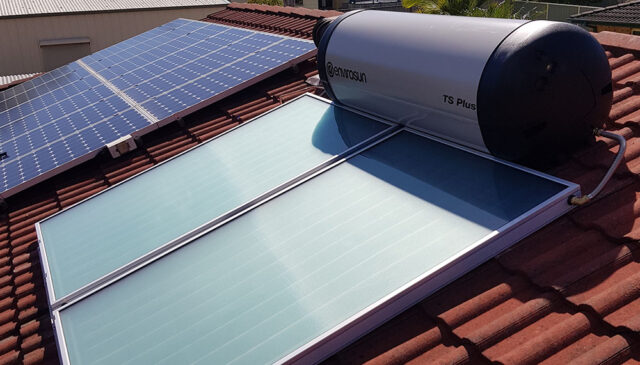
Cirrex
Firstly, Cirrex has one of the best efficiency ratings in the solar heater market space. They are an excellent choice for environmentally conscious homeowners and can boost energy savings by up to 70%.
Cirrex systems are Energy Star certified and have an OG-300 certification by the Solar Rating and Certification Corporation (SRCC) which means they are available for many states, local, and utility rebate programs. You can also access Federal tax credit all while making a tremendous environmental impact.
The solar collectors are supplied by Chromogen which is very durable and manufactured to a high-quality standard. They possess optimal heat absorption. The riser tubes are laser welded to the absorber plate which makes sure that heat leaks don’t occur during transfer and that there is always a permanent bond. Three insulation layers provide a combined thermal resistance value of R-8.
Furthermore, indirect solar booster tanks are used in conjunction with standard pump stations that have factory installation of internal single wall coil-type heat exchangers.
There is also the option of double wall pump stations available that have plate-type stainless steel heat exchangers and two circulation pumps. One of the pumps can be used for potable water and one for antifreeze in the solar circuit. These are used with direct solar booster tanks. Visit this page for details on how to contact a local installer in your area to have a Cirrex solar system outfitted in your home.
Here are two recommended Cirrex solar water heater systems:
Cirrex – SACE 04 100544 – 120
This solar water heater has a flat plate collector with indirectly forced circulation. It has an energy factor rating of 7.5 from EnergyStar. The auxiliary tank volume is 60 gallons, and solar tank volume is 120 gallons. The collector panel takes up 128 square feet. Date of certification is June 5, 2011.
Cirrex – SACE 04 100404 – 80
Made by A.O. Smith Corporation, this Cirrex sola water heater uses a flat plate collector which is great for warm climates. It has an 80-gallon solar tank with a 60-gallon auxiliary tank. The freeze tolerance limit is -30 degrees Fahrenheit. Moreover, its solar energy factor is 7.5 as stated by EnergyStar, and the whole system is an indirectly forced circulation.
Rheem
Rheem is another well-known company that manufactures and sells solar water heater systems. They have multiple different configurations available of which include:
- SolPak with Electric Backup
- SolPak with Gas Assist Heat Exchange Tank
- Solaride HE
- Universal Solaride
The SolPak models are available in both gas and electric backup configurations. They have an active solar water heating package, and the electric version includes a storage tank, collectors, controller, adjustable speed pump, and mixing valve.
The Universal Solaride model is great for storage applications and can be bought for an indirect or direct configuration. Available in both 80- and 120-gallon capacities.
For further details on the types of solar water heater available from supplier and installer in your area we recommend you visit the EnergyStar.Gov website.
Here, you can research individual products further and also check out some of the rebates or offers you are eligible for.
Concluding Information
Solar water heaters are a great way to save money, save energy, and save the environment. They can be configured depending on your home situation and climate type. Although they work best for those living closest to the equator, they can still add considerable savings and impact to homes situated in colder climates.
Plus, there are government incentives that can take hundreds of dollars off your purchase in the form of rebates. For example, Puget Sound Energy of Washington State offers a $250 rebate towards solar with gas backup water heaters. Duke Energy of North Carolina offers a $350 rebate. Nebraska’s Energy Office can even help you with a low-interest loan.
If you found this article even slightly helpful, slightly help us by sharing it on social media.

